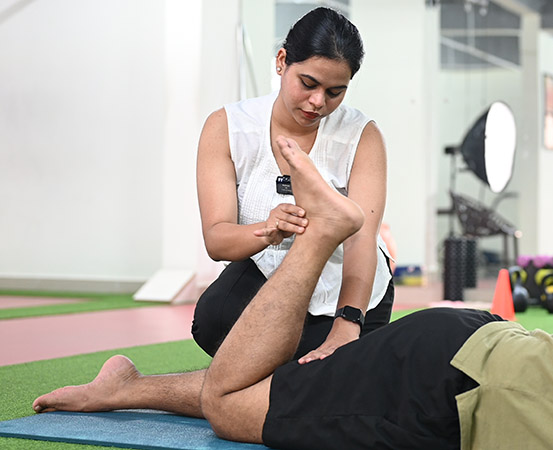
The anterior cruciate ligament (ACL) helps stabilise the knee joint and plays a major role in movement. It takes a lot of load and is hence prone to injuries. ACL tears are common among women and sportspersons.
“ACL tears are caused because of a pivoting movement,” says Bharath Raj, consultant orthopedic surgeon and managing director, Mithra Multispecialty Hospital, Bengaluru. “So, when the foot is planted, the ankle is locked, and [if one] tries to move forward, the ACL ligament tear happens.”
The ACL has two tissue bundles: the anteromedial and the posterolateral bundle. If one of the two bundles is torn, it is known as a partial ACL tear. Should both bundles be torn, it counts as a complete tear.
READ MORE :
Pain perception: Who feels it more, men or women?
How to get your eating posture right
Pain of dancing: Step away with the right moves
Sciatica: How to not let it hit a nerve
Groin pain: Truth lies in the hip adductors
Symptoms of ACL tear include popping sound or sensation, rapid swelling, impaired range of motion and instability or buckling of the knee.
“ACL tears do not present with a pain,” says Dr Bharath. “The pain arises mainly from meniscal or cushion tears. ACL tears cause instability in the knees. If the patient has pain, we need to find out the cause for the same.”
Treatment choices for ACL (anterior cruciate ligament) tear
“Since ACL is an intra-articular ligament, we do not really have the option of non-invasive [treatments],” explains Dr Bharath.
For complete tears, a reconstruction is recommended. For partial tears and associated meniscal tears, augmentation with rehabilitation is suggested. Reconstruction is not usually recommended for partial ACL tears unless and until there is a meniscal tear associated with it, in which case an arthroscopy [a minimally invasive keyhole surgery] is done. The treatment route is determined based on the patient’s needs and lifestyle.
ACL injury diagnosis
“If the X-ray does not show any signs of a fracture, it is assumed that it is either a ligament or a meniscal tear,” says Dr Bharath. “For this, we do a knee immobilisation, keep the patient on knee brace, apply ice so that the inflammation goes down, and after two weeks, reassess the joint stability.”
The two commonly used physical tests to examine the integrity (strength and laxity) of the ACL are the Lachman test and the anterior drawer test.
“If we suspect an internal ligament injury, we plan for an MRI scan, but only post four to six weeks, once swelling around the knee has gone down,” says Dr Bharath.
An MRI scan done at the time of injury could throw up misleading results due to the edema (swelling and fluid collection) at the injury site.
ACL (anterior cruciate ligament) reconstruction
ACL reconstruction involves taking a piece of tissue from another part of the knee (such as the patellar tendon) or the hamstring and using it to replace the torn ACL.
“While the bone-patellar-bone graft was predominantly used for reconstruction in the past, hamstring and peroneus longus grafts are in use currently as they have higher load-bearing capacity,” says Dr Bharat. “Earlier, reconstruction was a prevalent treatment. Today, extracting and reconstructing the entire ligament is avoided.”
ACL augmentation
ACL augmentation is a selective reconstruction surgery that uses a muscle from the body or a synthetic material to reinforce the ACL.
“If one of the two ACL bundles are torn, we augment it by reconstructing only that bundle, we don’t take out and reconstruct the entire ACL,” says Dr Bharath. “We take one of the three muscles — the gracilis, the semi-tendinosis or the peroneus longus muscle — and support [graft] it on to the existing ligament.”
According to a 2020 research article, ACL remnants may add biomechanical strength during the immediate postoperative period and maintain its blood supply, supporting the graft’s healing process. Moreover, the proprioceptive properties of the residual bundle may improve the final proprioception [sense of balance and movement] of the graft. These advantages make way for accelerated rehabilitation.
Rehabilitation exercises for ACL tears
Physical therapy is typically the first step in the recovery process and may include exercises to help restore range of motion, strength and stability. Out of 100 cases of ACL tears, usually 40 to 50% are partial tears, and the rest can build up muscle strength and recover, says Dr Bharath.
“In the four to six weeks post injury, and between injury and surgery [if planned], we prescribe static quadriceps exercises to build up the muscle strength,” he adds. “This applies even when an arthroscopy is planned.”
The rehabilitation process following ACL tear surgery is crucial. It takes several months and may include a gradual return to normal activities, such as walking and light jogging, followed by more strenuous activities such as running and jumping.
ACL tear surgery and rehabilitation is a process that requires patience and dedication. With the right care and attention, patients can fully recover.
Takeaways
- The anterior cruciate ligament (ACL) is a two-bundle ligament in the knee, prone to tears due to sudden pivoting movements.
- Treatment of ACL tears depends upon the degree of tear (partial or complete) and the patient’s needs.
- ACL tears can be managed by rehabilitation exercises, complete reconstruction surgery or by augmentation of the existing ligament with a muscle graft.
















